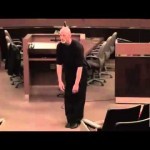Paper suggests some FM patients have short filium terminals. I would not be surprised at all. Rowe has found that neck and spine problems either cause or greatly contribute to some of his adolescent ME/CFS patients.
Muscles Ligaments Tendons J. 2015 Mar 27;5(1):33-7. Shortness of filum terminale represents an anatomical specific feature in fibromyalgia: a nuclear magnetic resonance and clinical study. Mantia R1, Di Gesù M1, Vetro A1, Mantia F1, Palma S2, Iovane A3.
BACKGROUND:
we aimed to assess whether shortness of filum terminale (FT) can represent a specific feature of fibromyalgia. Therefore we investigated benefits coming from FT section with a mini-invasive technique in patients with fibromyalgia. Filum terminale disease (FD), described firstly in 1996, is consequence of an abnormal traction exerted on spinal cord since FT is shorter than usual. Fibromyalgia syndrome (FS) is featured by chronic widespread musculoskeletal pain associated with stiffness and extra-skeletal symptoms affecting many organs and systems. Filum terminale disease and fibromyalgia syndrome share common clinical features in at least one subset of patients.
METHODS:
we evaluated 42 patients firstly diagnosed for FS and then re-evaluated by nuclear magnetic resonance. 38 out of 42 had also FD and 20 of them underwent surgical treatment, i.e., FT section according to Royo-Salvador technique.
RESULTS:
after physical therapy, surgically treated patients showed significant improvement of symptoms in terms of reduction of pain and increment of quality of life, compared to group, which refused surgery and performed physical therapy only.
CONCLUSION:
we suggest that FT shortness can be considered one of predisposing causes for developing FS and that FD surgical treatment in patients with FS can improve overall treatment outcome.
In tight filum terminale syndrome, the spinal cord is tightly tethered. When a person moves the spine to stretch and bend, as happens regularly during daily activities, the abnormal filum terminale cannot flex to accommodate this and the spinal cord, together with its nerves, ends up stretching instead. Over time this causes damage to the nerves, especially those arising from the lower part of the spinal cord, and symptoms arise affecting the parts of the body they supply. Pain in the lower back can occur, and a curved spine may be seen, together with deformed feet and weak legs. There can be problems with walking — the legs and feet might feel numb — with one limb growing more than the other, and bladder and bowel control may deteriorate over time.













